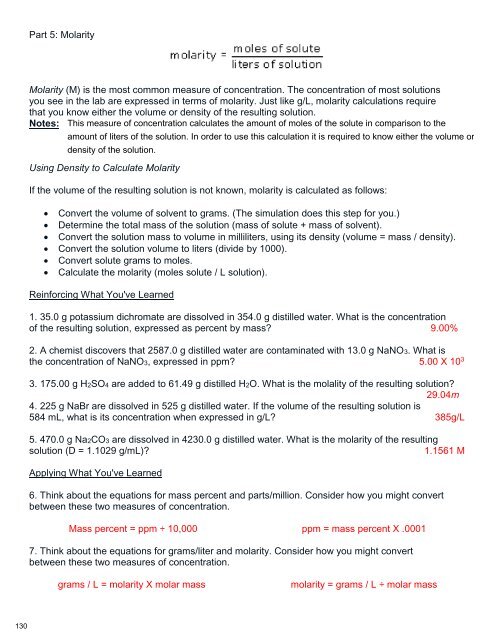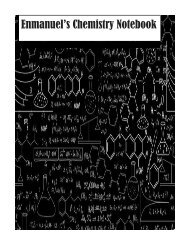You also want an ePaper? Increase the reach of your titles
YUMPU automatically turns print PDFs into web optimized ePapers that Google loves.
Part 5: Molarity<br />
Molarity (M) is the most common measure of concentration. The concentration of most solutions<br />
you see in the lab are expressed in terms of molarity. Just like g/L, molarity calculations require<br />
that you know either the volume or density of the resulting solution.<br />
Notes:<br />
Using Density to Calculate Molarity<br />
If the volume of the resulting solution is not known, molarity is calculated as follows:<br />
Convert the volume of solvent to grams. (The simulation does this step for you.)<br />
Determine the total mass of the solution (mass of solute + mass of solvent).<br />
Convert the solution mass to volume in milliliters, using its density (volume = mass / density).<br />
Convert the solution volume to liters (divide by 1000).<br />
Convert solute grams to moles.<br />
Calculate the molarity (moles solute / L solution).<br />
Reinforcing What You've Learned<br />
1. 35.0 g potassium dichromate are dissolved in 354.0 g distilled water. What is the concentration<br />
of the resulting solution, expressed as percent by mass? 9.00%<br />
2. A chemist discovers that 2587.0 g distilled water are contaminated with 13.0 g NaNO3. What is<br />
the concentration of NaNO3, expressed in ppm? 5.00 X 10 3<br />
3. 175.00 g H2SO4 are added to 61.49 g distilled H2O. What is the molality of the resulting solution?<br />
29.04m<br />
4. 225 g NaBr are dissolved in 525 g distilled water. If the volume of the resulting solution is<br />
584 mL, what is its concentration when expressed in g/L? 385g/L<br />
5. 470.0 g Na2CO3 are dissolved in 4230.0 g distilled water. What is the molarity of the resulting<br />
solution (D = 1.1029 g/mL)?<br />
1.1561 M<br />
Applying What You've Learned<br />
6. Think about the equations for mass percent and parts/million. Consider how you might convert<br />
between these two measures of concentration.<br />
Mass percent = ppm ÷ 10,000 ppm = mass percent X .0001<br />
7. Think about the equations for grams/liter and molarity. Consider how you might convert<br />
between these two measures of concentration.<br />
grams / L = molarity X molar mass<br />
molarity = grams / L ÷ molar mass




